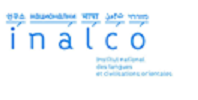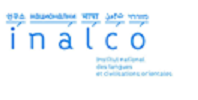
Main menu
HELP
|
INALCO, Paris, Novembre 3-4, 2021
Organizer: Ghanshyam Sharma (INALCO, PLIDAM, LABEX-EFL) Even though the Hindi language has been knowledgeably researched by a significant number of accomplished modern linguists in the last sixty years or so, much of the needed research carried out during this period of time is theory-oriented rather than language-oriented. Consequently, a great deal of the Hindi data which has been used to carry out linguistic analyses is subject to having been purposefully fabricated. Regrettably, while such types of data may serve to open up a theory-oriented discussion within some linguistic framework, they deflect scholarly attention away from many unexplored structural aspects of the Hindi language. On the lexical side, if we carefully look at the lexicographical development of Hindi during the last century, we notice that most of the prestigious monolingual dictionaries of Hindi list loads of ancient words of Sanskrit origin as the core vocabulary of Hindi whereas only a few try to deal with the corpus of spoken Hindi. Unfortunately, none of these dictionaries addresses the key issues related to the standardization of Hindi lexicon. Due to this complex situation, the Hindi teacher often has to confront many challenges. On one hand, he or she naturally clings to the idea that a time-honored and deep tradition of historical Sanskrit grammar and lexicon represent the only useful tools to be used in the teaching of Hindi. On the other hand, he or she has to keep pace with recent developments and apply new insights from modern linguistic research in the classroom. These contradictory requirements can impede successful Hindi language teaching. This international conference is intended to provide a needed platform for scholars from diverse schools of thought working in the field of teaching Hindi as a foreign or second language and who want to share their experiences with other colleagues engaged in the same field. Two days of this academic conference will include four plenary talks along with a general session or, if needed, two parallel sessions to consider various key issues in Hindi grammar and lexicon. All studies that aim to carefully explore any central component of Hindi grammar (i.e. phonology, syntax, semantics or pragmatics, etc.) and have some bearing on a successful Hindi teaching are welcome as are those classroom experiments which open up alternative paths to teaching Hindi effectively. On the lexical side, those comparative studies that properly investigate different Hindi registers and those based on comprehensive analysis of Hindi vocabulary (i.e. tatsam, tadbhav, etc.) are particularly welcome. Abstracts of research papers on all topics in Hindi grammar and lexicon concerning the teaching of Hindi as a second language are welcome. Although due to its international setting the conference will have English as the working language, original proposals written in Hindi will also be considered. All proposals must be anonymous, in Word format and no longer than two pages. Please submit your abstract to Ghanshyam Sharma (INALCO, Paris): hindi.paris@gmail.com Selected papers will be submitted to Mouton de Gruyter of Berlin for publication. Submission deadline: May 31, 2021 (extended until June 30, 2021) Notification of acceptance: July 31, 2021
Place: Paris, INALCO, November 5, 2021
Date: 5th November 2021 Co-organizers Émilie Aussant (CNRS UMR7597 HTL, Université de Paris, LabEx EFL) Ghanshyam Sharma (INALCO, PLIDAM, LabEx EFL) Description: This workshop is devoted to Hindi grammars and lexica in a historical perspective, in the same spirit as the workshops previously organized within the “Extended Grammars” program of the LabEx Empirical Foundations of Linguistics (“Extended Sanskrit Grammar”, “Exogenous Grammars of Armenian”, “Extended Arabic Grammar”, “Extended Greek Grammar”). Descriptions of Hindi, which cover a continuous period of almost three centuries, are rooted in two exogenous grammatical traditions: the Greco-Latin tradition, introduced into India by European missionaries, settlers or merchants (the most ancient Hindi grammar which has come down to us is written in Dutch) and the Sanskrit tradition. The descriptive models elaborated by both these grammatical traditions were diversely – and more or less successfully – adapted in order to explain Hindi data and make its acquisition as a primary or a secondary language possible. The history of grammatical descriptions of Hindi thus constitutes a highly stimulating field of research for those who are interested in the “Extended Grammar” phenomenon. Moreover, contrary to the Sanskrit and the Tamil grammatical traditions which have been studied for centuries now in India and beyond, the description of Indian vernaculars has so far not really caught researchers’ attention. This workshop aims at filling this gap, at least in part. Work on Hindi lexica is anchored in three distinct lexicographic traditions: Sanskrit, Persian and Greco-Latin. It is generally considered that the first autonomous works on the Hindi lexicon date back to the 14th c.: the first representative would be the Khalikbari composed by the well-known poet Amir Khusro (a Turk born in India) in 1340. This work, which does not limit itself to the nouns (it includes particles), provides various synonyms coming from different dialects of ancient Hindi, from Persian and from Turkish. Up to the composition, from 1922 to 1929, of the great Hindi Shabd Sagar dictionary by the Nagari Pracharini Sabha of Benares, numerous monolingual or bilingual works were composed by Indian or foreign scholars, for literary composition or language learning. Research presented during this workshop will aim at answering the following questions, among others: how is Hindi depicted in grammars and dictionaries (as a unified linguistic variety among others? As a language with dialectal varieties? As a linguistic variety derived from Sanskrit?...)? What forms does its constitution take? How and with what degree of success are the grammatical models elaborated for Sanskrit or Greco-Latin adapted to Hindi? How does the specificity of Hindi emerge through these adapted works? Selected papers will be published in a special issue of a journal. Request for information and proposals should be sent to : emilie.aussant@u-paris.fr Timetable Deadline for abstracts (no longer than 500 words, with bibliography): 18th June 2021 Notification of acceptance: 10th July 2021 |
| Online user: 2 | Privacy |

|






